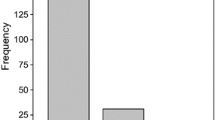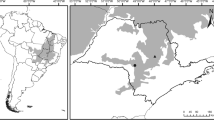Abstract
In the spring of 1998, an outbreak of the cedar processionary moth (CPM) [Traumatocampa ispartaensis (Doğanlar and Avcí 2001)], a notodontid moth, began on 400 ha in a 75-year-old stand of Lebanon cedar (Cedrus libani A. Rich.) trees in the western Mediterranean region of Turkey. This was the first monitored outbreak of CPM in the Isparta region. Tree crowns recovered to near normal condition by the middle of each growing season (beginning of July) during the outbreak. From 1999–2003, CPM larvae were present in the same stands and again caused defoliation. The objective of this research was to explore dendrochronology as a means of determining the long-term role of CPM in tree growth and to quantify the historic importance of CPM. In 2003, increment cores were collected from 28 host and 10 nonhost dominant or codominant trees, and annual radial-growth indices from 1947–2003 were calculated for one nonhost and four host sample plots. Cedar tree-ring chronologies were analyzed for evidence of CPM. Tree-ring chronologies from nonhost cedar (undefoliated sample trees) were used to estimate potential growth in the host cedar (defoliated sample trees) during current and past outbreaks. The trees selected as host and nonhost were the same subspecies and varieties. We identified regional outbreaks of CPM by synchronous and sustained growth periods of the trees. Growth functions were defined as the cumulative sum of radial increments. Tree-ring evidence suggests that a large-scale outbreak began in 1954 (lasting from 1954–1961) and small outbreaks began in 1947 (1947–1951), 1985 (1985–1988), and 1998 (1998–2003) in the study area. The average reductions in diameter growth for the periods around 1947, 1954, 1985, and 1998 were 40, 28, 17, and 10% of potential, respectively. We concluded that a narrow latewood band is a significant historic indicator of defoliation by CPM, and the outbreaks appear to be associated with dry winter and spring weather prior to the fall and winter in which feeding occurred.




Similar content being viewed by others
References
Alfaro RI, Van Sickle GA,Thomson AJ, Wegwittz E (1982) Tree mortality and radial growth losses caused by the western spruce budworm in a Douglas fir stand in British Columbia. Can J For Res 12:780–787
Avcí M (2003) Parasitism of egg-batches of the cedar processionary moth Traumatocampa ispartaensis in Turkey. Phytoparasitica 31(2):188–123
Blais JR (1985) The ecology of the eastern spruce budworm: a review and discussion. In: Recent advances in spruce budworm research: proceedings of the CANUSA research symposium, Canada, pp 45–49
Carlson CE, McCaughey WW (1982) Indexing western spruce budworm activity through radial increment analysis. USDA Forest Service Reoprt, INT-291
Colbert JJ, Fekedulegn D (2001) Effects of gypsy moth defoliation on tree growth preliminary models for effects of cumulative defoliation on individual host tree radial increment. In: Proceedings of the integrated management and dynamics of forest defoliating insects, Victoria, BC, 15–19 August 1999. General Technical Report, US Forest Service, NE-277, pp 16–30
Cook ER, Holmes RL (1986) Guide for computer program ARSTAN. In: Tree ring chronologies of western North America: California, eastern Oregon and northern Great Basin. University of Arizona, Tucson, pp 50–65
Copenheaver DA, Abrams MD (2003) Dendroecology in young stands: case studies from jack pine in northern Lower Michigan. For Ecol Manage 182(1–3):247–257
Doğanlar M, Avcí M (2001) A new species of Traumatocampa Wallengren (Lepidoptera: Thaumetopoeidae) feeding on cedar from Isparta (Turkey). Türk Entomol Derg 25(1):19–22
Evcimen BS (1963) The yield, economic important and management basis of the Lebanon cedar forests (Turkish with English summary). O.G.M. Publication no. 355/16. Ankara, Turkey
Fritts HC (1976) Tree rings and climate. Academic, London
Fritts HC, Swetnam TW (1989) Dendroecology: a tool for evaluating variations in past and present forest environments. Adv Ecol Res 19:111–188
Holmes RL (1983) Computer assisted quality control in tree ring dating and measurement. Tree Ring Bull 43:69–78
Holmes MJ, Reed DD (1991) Competition indices for mixed species northern hardwoods. For Sci 37(5):1338–1349
MacLean DA (1985) Effects of spruce budworm outbreaks on forest growth and yield. In: CANUSA spruce budworms research symposium, Bangor, ME, 16–20 September 1984, pp 148–175
Mattson WJ, Haack RA (1987) The role of drought in outbreaks of plant eating insects. Bioscience 37:110–118
Muzika RM, Leibhold AM (1999) Changes in radial increment of host and nonhost tree species with gypsy moth defoliation. Can J For Res 29:1365–1373
Naidoo R, Lechowicz MJ (2001) Effects of gypsy moth on radial growth of deciduous trees. For Sci 47(3):338–348
Petal J (1978) The role of ants in ecosystems. In: Brain MV (ed) Production ecology of ants and termites. Cambridge University Press, London, pp 293–325
Piene H, Ostaff DP, Eveleigh ES (2001) Growth loss and recovery following defoliation by the balsam fir sawfly in young, spaced balsam fir stands. Can Entomol 133:675–686
Ryerson DE, Swetnam TW, Lynch AM (2003) A tree ring reconstruction of western spruce budworm outbreaks in the San Juan Mountains, Colorado, USA. Can J For Res 33:1010–1028
Speer JH, Swetnam TW, Wickman BE, Youngblood A (2001) Changes in Pandora moth outbreak dynamics during the past 622 years. Ecology 82(3):679–697
Swetnam TW, Thompson MA, Sutherland EK (1988) Using dendrochronology to measure radial growth of defoliated trees. USDA Forest Service, Spruce Budworms Handbook No. 639
Swetnam TW, Lynch AM (1993) Multicentury, regional-scale patterns of western spruce budworms outbreaks. Ecol Monogr 63:399–424
Author information
Authors and Affiliations
Corresponding author
Rights and permissions
About this article
Cite this article
Avcí, M., Carus, S. The impact of cedar processionary moth [Traumatocampa ispartaensis (Doğanlar & Avcí) (Lepidoptera: Notodontidae)] outbreaks on radial growth of Lebanon cedar (Cedrus libani A. Rich.) trees in Turkey. J Pest Sci 78, 91–98 (2005). https://doi.org/10.1007/s10340-004-0073-2
Received:
Published:
Issue Date:
DOI: https://doi.org/10.1007/s10340-004-0073-2




